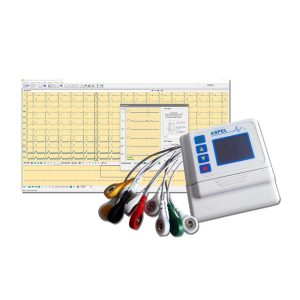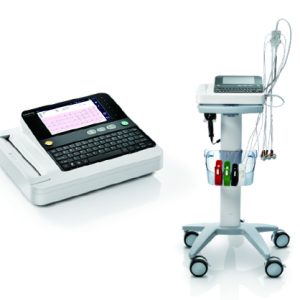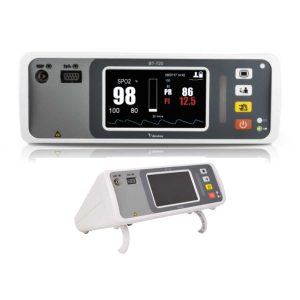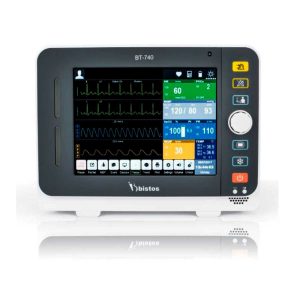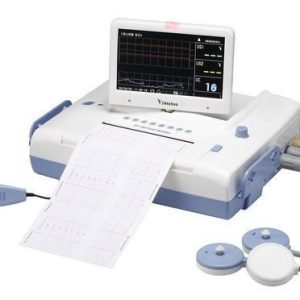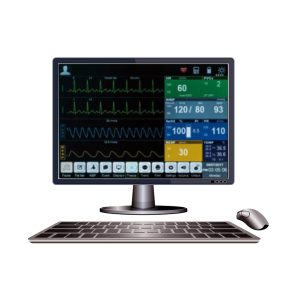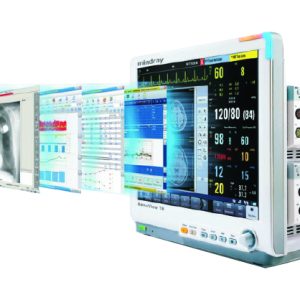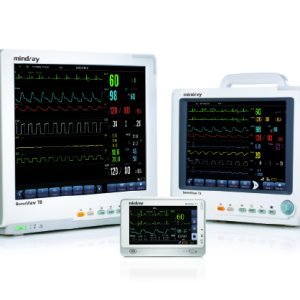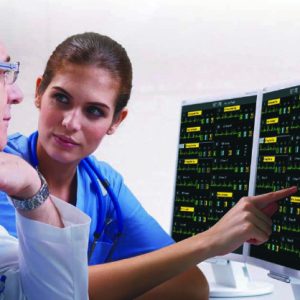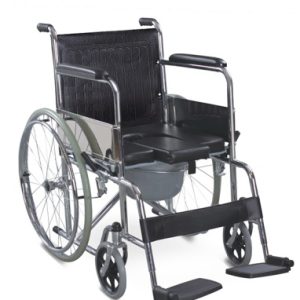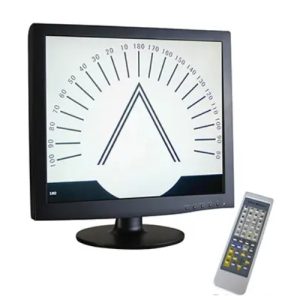-
The Holter Monitor allows quick analysis of ECG examination (arrhythmias and ST segment). Technical specifications: HolCARD 24W Software: fully compatible with Microsoft Windows environment unbeatable tool for alternative placement of electrodes independent analysis of the ST segment in all recorded channels, the positioning of all measurement points is user-reconfigurable and may depend on heart rate simultaneous arrhythmia detection in all three channels automatic signal calibration independent in all channels assures the use of all dynamic range available detection, reviewing and editing capability in the qualitative assessment of VE, VT, Single SVE, PSVT, Pauses, Irregular Rhythm, VT, IVR, Brady – and Tachycardia, Couplets, ST-segment elevation and depression, Maximum, Minimum and averaged Heart Rates, artifacts validation tool for beat classification making the correction easy and effective tabular hourly summaries all quantitative results printing of all recorded ECG signal available AsPEKT 712 Recorder: 12-channel digital registration of the ECG signal 10-lead patient cable registration time: 48 hours or 7 days on SD card built-in the real time clock EVENT button pacemaker detection dimensions: 72x76x23 mm Click Here To Download Catalogue
ASPEL AsPEKT 712 Holter Monitor and Software
-
R12 provides easy-to-use experience to customers as well as professional analysis for various clinical demands. Modern and practical design Ergonomic look and simple layout enable R12 to achieve user’s satisfaction: 8-inch LCD screen with 800*400 high resolution Frosted membrane keyboard. Typing and editing can be as easy and comfortable as using a computer Optional touch bars for users with different operating preferences Built-in thermal printer and external USB printer supported Minimized workload and optimized workflow On-screen full preview maximizes user’s flexibility without printing a paper report. Barcode scanner supported. Shorten the time of information input. Retrieve history record on screen for at most 800 copies Hot keys for common-used functions Re-analyze and generate a new report once the patient information is modified. Device configuration is able to print/export/import Reliable diagnostic analysis and outstanding performance Pediatric-friendly. Unique design in V4R(C4R) proves to be ideal for determined young-age group. World top-level algorithm: Glasgow. Use more variables than usual for analysis with higher accuracy. (age, gender, race, etc.) Pacemaker detection. Prevent potential misinterpretation from missing the pacer information. Six Critical Values for typical Arrhythmias allow users to notice issues in time. Rechargeable 4500 mAh Li-ion battery enables a longer working time IT solutions/Data transfer Wired/wireless transfer of patient’s record to ECG management system for sharing/further analysis Multi-format exports available
BeneHeart R12
-
Bistos BT – 720 Patient Monitor: Bistos Portable Patient Vital Signs Monitor, SpO2, Pulse, *NIBP, BT-720. The Bistos BT-720 is a compact size vital signs monitor with the standard parameters of SpO2 and Pulse. You can also add the NIBP and/or Masimo SpO2 at an additional cost. The BT-720 has a 4.3″ color touch screen The PC software allows the vital signs information to be transferred and analyzed on a computer. Features: 3″ color touch screen Standard Confirgurations: SpO2 and Pulse Optioal NIBP and Masimo SpO2 Short/long trend graphic/trend table display Audio and visual alarm, adjustable alarm limit Automatic brightness adjustment Accurate SpO2 reading during motion or low perfusion Perfusion index data / bar graphic display Pitch tone variation for pulse rate Internal memory for data storage SD card for easy software upgrade Over 8 hours of operation with the re-chargeable li-ion battery PC software for data review and analysis on a computer Technical Specifications: Model BT-720 Display 4.3″ Color LCD Touch Screen SpO2 Measurement Range 0-100% Accuracy (70-100%) Adult/Pediatric +/- 2% Neonate +/- 3% Accuracy (0-69%) Unspecified Perfusion Index 0.05-20% Pulse Rate Range (bpm) 25-250 NIBP* (Optional) Method Automatic Oscillometric Operation Mode Manual/Automatic/STAT Parameter Systolic/Diastolic/Mean Systolic Range (mmHg) Adult 40-270 Pediatric 40-200 Neonate 40-130 Diastolic Range Adult 100-210 Pediatric 100-160 Neonate 10-90 Mean Range Adult 20-230 Pediatric 20-175 Neonate 20-100 SpO2 Masimo* (Optional) Masimo SpO2 Battery Type (Capacity) Li-ion (4400mAh) Run time 8 Hours Charging Time 8 Hours Interface RJ45, SD Card Slot Warranty 2 Years Click Here To Download Catalogue
Bistos BT- 720 Patient Monitor
-
Bistos BT – 740 Patient Monitor: Bistos Patient Vital Signs Monitor, ECG, Resp., SpO2, NIBP, Temp., BT-740. The Bistos BT-740 is a multi-parameter patient monitor with an 8.4″ TFT Color screen. The standard paramaters are ECG, respiratory, SpO2, NIBP and temperature. Additional options are EtCO2, IBP, Multi-gas, CO and Masimo SpO2. The BT-740 has a fanless design for quiet operation. Features: 8.4″ TFT Color Screen – (Optional Touch Screen Upgrade) Standard parameters are ECG, Resp., SpO2, NIBP, Temp. Ultra-low power consumption Quiet operation High accuracy SpO2 reading Data transfer or firmware upgrade via USB 2 Years Manufacturer’s Warranty Technical Specifications: Model BT-740 Display 8.4″ Color TFT Screen ECG Lead type 3/5 Lead Gain Selection x0.25, x0.5, x1, x2, x4, auto Sweep speed (mm/s) 12.5, 25, 50 Bandwith:(Diagnostic Mode) 0.05-130Hz Monitoring Mode 0.5-40Hz Surgery Mode 1-25Hz Strong Mode 5-20Hz Heart Rate Range (bpm) Adult:15-300 Pediatric/neonate: 15-350 Respiration Method Trance-thoracic Impedance Measurement Range 0-120rpm Sweep Speed (mm/s) 6.25, 12.5, 25 SpO2 Measurement Range 0-100% Accuracy (70-100%) Adult/Pediatric +/-2% Neonate +/-3% Accuracy (0-69%) Unspecified Perfusion Index 0.05-20% Pulse Rate Range (bpm) 25-250bpm NIBP** Method Automatic (Oscillometric) Operation Mode Manual/Auto/STAT Parameter Systolic, Diastolic, Mean Systolic Range (mmHg) Adult 40-270 Pediatric 40-200 Neonate 40-130 Diastolic Range (mmHg) Adult 10-210 Pediatric 10-160 Neonate 10-90 Mean Range (mmHg) Adult 20-230 Pediatric 20-175 Neonate 20-100 Temperature Range 0-50°C Parameter T1, T2 and TD IBP” Channel 2 Channel, 4 Channel Range (mmHg) -50-400 Printer* Type Thermal dot array Print Speed (mm/s) 12.5, 25, 50 Paper Size (mm) 50 CO2* Sidestream Masimo ISA / Bistos Mainstream Masimo IRMA / Bistos Multi-gas O2* Masimo ISA SpO2 Masimo* Masimo SpO2 CO* Method Thermodilution Range 0.2-20 L/min Battery Type (Capacity) Li-ion (440mAh) Run Time 6 hour Charging Time 4 hour Interface RJ45, USB, Nursing Call Warranty 2 Years Click Here To Download Catalogue
Bistos BT- 740 Patient Monitor
-
Product Details: Minimum Order Quantity 1 Piece Model BT-350 Dimension 80mm (H) X 330mm (L) X 280mm (D) Application Hospital Brand Bistos Screen rotating 180 Degree LCD display 7″ wide TFT color LCD display Product : Up to 150 patients date saving Fetal heart sound play and record in PC Multiple language support Quick guide display Various installation method Dual Pulsed Doppler: Ultrasound Frequency: 0.985MHz Intensity: 10mW/cm2 or less FHR Range: 30~240bpm FHR Accuracy: ±2% of Range Auto-detection of Dual Fetal Movement External Type Frequency Response: DC~0.5HZ Reference(Zero) Control Measurement Range: 0~99 units Printer: Thermal Array Type Print Speed: 1,2,3, cm/min, high speed Auto print: Off,10,20,30,40,50,60 min Paper Feeding Function Display: 3 Channels (FHR I, FHR II, UC) 7″ Wide TFT-Color LCD:800(W) X 480(H) BT-350LCD Large 7-segment volume lever LED : BT-350 LED Function: Mark Function FHR II Offset Function Auto Print function Fetal movement print function Multi-language quick guide function: BT-350 LCD Trend: Data Saving for 450 hours(3hr/person): BT-350 LCD Accessory Standard: Ultrasound Doppler Probe 2ea Event Marker Jack 1ea Power Adaptor Cord 1ea Probe Belt 3ea Click Here To Download Catalogue
Bistos BT-350 Fetal Monitor
-
Central Monitoring System can be defined as a continuous observation or monitoring of a patient vital sign during treatment while on life support equipment for the purpose of guiding management decisions, including when to make therapeutic interventions and assessment of those interventions. Central monitoring system involves the connectivity of patient monitors together on a network which enables healthcare givers to monitor patients recovery progress from another remote location over a local or wide area network. Bistos Patient Central Monitoring System Software the monitor assistant has some functions below: Up to 10 and above bedside monitors connectable display of holographic waveforms of the view bed of single bedside monitor; display of ECG.RESP.CO2.PLETH IBP waveforms and so on. Alarm manage parameter alarm events for each bedside monitor; S-T segment alarm events; arrhythmia alarm events. Alarm prompt modes: sound and lightwave. Storage and review of 24-hour holographic waveforms Storage and review of up to 240-hour trend data for each bedside monitor Storage and review of u to 720-item alarm events for each bedside monitor Review of five parameters and 6minutes short trend for each bedside monitor All the review information will be stored under off-state Display of continuous multi-lead ECG and single-lead arrhythmia analysis for each bedside monitor. Trend records and alarm records can be output according to a certain format. Patient information management: receive cancel input and educe Central Monitoring System gather function: relying on the data transmission the system has the capability that in different position could simultaneously monitor the bedside monitors in the courtyard All-round system help information including operation guide of this system and bedside monitor. Multi-language display interface support screen (dual-screen display) Support keyboard and mouse input Bistos Patient Central Monitoring Specification: System Configuration Demand 1. Computer configurationCPU: 1GHz or aboveMemory: 4G or aboveHard disc: 500GB or aboveNIC: 100M self-adaptiveSound card: 16-bitMonitor: 19 inch or above Operating system: WINDOWS 7 or above 2. Printing system: printer 3. Switch/ Hub: 10M/100M self-adaptive 4. Network cable: Straight-through cables (same colour definition for the 2 ends)
Bistos Central Monitoring System
-
Powerful Monitoring Functions With its wide range of monitoring functions, the BeneView T1 is suitable for patients at all levels of acuity. During transport, it also supports advanced parameters, such as PiCCO and EtCO2. Smart and Compact Design Weighing less than 1kg, the T1 is extremely compact and portable. The intuitive touch screen interface complies with the BeneView platform and simple to learn and operate. The display features automatic brightness control to ensure optimum data visibility under a variety of lighting conditions. Seamless Data Transfer The T1 guarantees the continuity of patient data during transport. When removed from the BeneView bedside monitor, the T1 automatically connects through Wi-Fi to the central monitoring station. All data collected during patient transport is synchronized when the T1 is connected again to a BeneView bedside monitor.
Mindray BeneView T1
-
Your Sophisticated Information Manager for Critical Care Optimized Visibility and Usability The high-resolution colour touch screen display ofers exceptional visibility for all critical parameters. Customizable quick keys allow for direct access to every function. Improved Data Management Extensive data storage and management capabilities let caregivers conveniently review, export and manipulate all patient information. Advanced calculation tools provide efective diagnostic support. Advanced Information Platform BeneView features advanced connectivity options and can be quickly integrated with other patient monitors, the central monitoring system as well as with the HIS and CIS. Information can also be retrieved directly from other critical care devices, such as anaesthesia machines or ventilators.
Mindray BeneView T1/T5/T8
-
Powerful Networking Capability The Hypervisor VI, supports up to 32 bedside patient monitors in the standard coniguration. The ADT module supports admission, discharge and transfer of patients while reducing the risk of transcription errors. The CMS Viewer function allows access to the patient monitoring system by the internet. Flexible and Adaptive Structure The system supports up to four displays and can be quickly adjusted according to the user requirements. Up to four remote displays and the CMS Viewer function allows clinicians view patient monitoring information when and where they want. Intuitive Operation Bi-directional controls between the Hypervisor VI and bedside monitors reduce clinician workloads and improve efficiency. The intuitive tabular menu is easy to learn and requires little training
Mindray Central Monitoring System
-
Foldable chromed steel frame U shape commode seat Fixed armrest & footrest Solid castor & rear wheel
MODEL FS 609
-
Monitor Chart Features: 19-inch high contrast and bright display; Smooth and quiet operation; Wireless Remote Control; Wide range of test types; Precise distance adjustment; Easy mounting; Random test sequence. Specifications: Display 19” LCD (color) High resolution Monitor Brightness 250 cd/m2 Chart versions E, C, ABC, 123, child, special version charts Chart acuity 6/3-6/150 20/10-20/500 0.04-2.0 Distance 2.0 ~ 7.0m Power supply Input: AC100~240V ,50/60Hz Power consumption ≤45W Dimension 455mm (L) x 420mm(W) x 110mm(H) Weight 4.2kg (Net. Weight) Remote IR Batteries for remote control 3A
Monitor Chart

Zenrox Healthcare Solutions - Advanced Medical Equipment in Lagos
Zenrox offers cutting-edge medical equipment and comprehensive support services in Lagos. Explore our products designed for superior healthcare delivery. Contact us today for innovative medical solutions.

